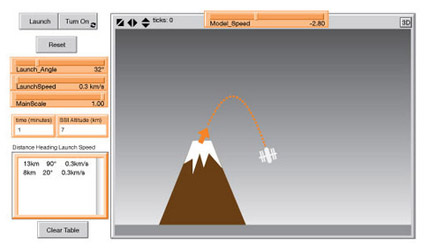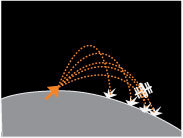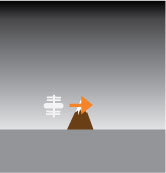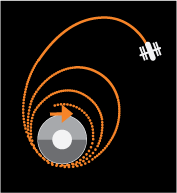Monday’s Lesson: Satellites in Orbit
Satellites can stay in orbit almost forever, but only if they are high enough. Because it is so massive, the International Space Station (ISS) has to stay in low orbit, about 350 km above the Earth. At this altitude, air friction causes the ISS to lose over 30 km in altitude every year. So thrusters have to give it a boost every few months to keep it in orbit. Otherwise it would enter the atmosphere, burn up, and rain more than 300 tons of flaming debris onto some unlucky location on the Earth.
However, in a few years the ISS will be obsolete and too expensive to keep in orbit. Would you send it into deep space or arrange for a controlled crash in an uninhabited spot on Earth?
With a series of simulations, your students can explore these questions. Use the Newton’s Cannon simulation to get a feel for orbits. Then use the ISS simulation to investigate whether the fate of the ISS should be the Pacific Ocean or deep space.
Newton’s Cannon

In 1728 Isaac Newton imagined a cannonball fired from a cannon on top of a tall mountain. He reasoned that gravity could bend the path of the cannonball. Under the right conditions, he hypothesized, the cannonball could orbit the Earth much the way the moon does. It might even go around the Earth and hit the back of the cannon!

With the help of a NetLogo model, we can test Newton’s ideas. Go to: concord.org/activities/launching-satellite
To run Newton’s Cannon (see Figure 1), click the Turn On button and leave it on (the button turns black).
Press Launch and watch as the ISS crashes. You’ll see an explosion and some debris that marks the landing spot. Experiment with different launch angle and speed settings.
If you increase the launch speed, the ISS zooms off the screen. Change the Main Scale slider to zoom out and watch this happen.
Guided inquiry
After free exploration, encourage students to be systematic with their research. Have them answer the question: What launch speed and angle will make the ISS orbit?

Assign a different launch speed to each group of students. Depending on the number of groups, assign steps of 1.0 km/s or 0.5 km/s. (Be sure one groups gets 8.0 km/s.) Ask each group to find the launch angle that gives the greatest range. For instance, Figure 2 shows a series of launch angles for a starting speed of 5 km/s. As they experiment with various settings, students can keep track of their results with the table on the lower left of the model.
Collect the results from each group. You should find that the maximum range starts out around 45° or 50° for low launch speeds and slowly increases to 90° at 8 km/s at which time the ISS orbits, as shown in Figure 3.
Challenge 1
Challenge students to reproduce Figure 4, which shows the International Space Station just before completing one full orbit. (To do this, students need to change the scale to get a close-up view. They also need to use the Model Speed slider to slow down the ISS as it gets close to the launcher. To take a screenshot, stop the model using the Turn On button.)
The ISS simulation
The ISS simulation is similar to Newton’s Cannon, but modified to start with the ISS in orbit. It also has a small thruster that can be used to lift the ISS into a higher orbit or to bring it to Earth.

Go to: concord.org/activities/launching-satellite
- Click Run, then click Launch to see the ISS in orbit 350 km above the Earth.
- 2. Use ISS-Direction to turn the ISS to face left or right of its forward direction, or backward.
- 3. Each time you fire, you give the ISS a tiny impulse forward. Impulse is measured in thousands of Newton-seconds or kNs. You can adjust the impulse delivered each time you fire.
The thrust is tiny and you may have to fire many times to have a noticeable effect.
Figure 5 shows one strategy that has not yet resulted in escape after 400 kNs were expended. Have your students try to get the ISS far out into space so it never returns.
Next, try to get the ISS to “de-orbit” as the space jockeys say. Find a strategy that uses the least amount of fuel, since fuel is so expensive. It should be possible to bring it down with less than 20 kNs. This shows why NASA prefers the de-orbit strategy to sending it into deep space. The real ISS does not have thrusters capable of delivering 20 kNs. So, to de-orbit the ISS, a new thruster and its fuel will have to be sent up to the ISS to bring it down safely.

Challenge 2
Have your students try to get the ISS to crash at a predetermined spot. A good choice for a crash site is the mountain just under the launcher. A successful effort will require coordination of the model speed and scale.
The VISUAL project
One of the most unusual visual aspects of these simulations is the treatment of scale. Science requires students to be fluent with ideas of scale, but they rarely experience the tremendous ranges of scale that occur frequently in science. The scale slider in these models covers almost five orders of magnitude. The 8.8 km mountain, the blue atmosphere at 50 km, the ISS launcher at 350 km, and the 6,378 km radius of Earth help establish visual references.
These simulations are being developed in collaboration with researchers at the University of California, Berkeley, as part of the National Science Foundation-funded project called VISUAL, Visualizing to Integrate Science Understanding for All Learners. We are studying how eighth grade students learn from interactive visualizations. In addition to helping students consider the fate of the International Space Station, we hope these simulations help them visualize the range of scale from one mountain to the whole Earth—and everything in between.
Robert Tinker (bob@concord.org) is President Emeritus of the Concord Consortium.
